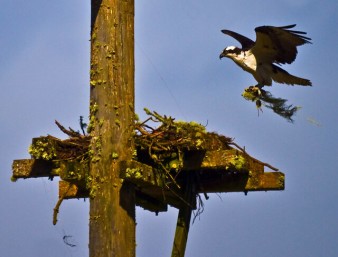The battle to save two of our biggest birds of prey from extinction may be one of the most celebrated success stories of the twentieth century. Facing an uncertain future 50 years ago, bald eagle and osprey populations are now flourishing.
Both species of birds have had limited protection since the passage of the Migratory Bird Treaty Act in 1918 and subsequent amendments. The act prohibits killing, selling, or otherwise harming migratory birds, their nests, and eggs.

Bald and golden eagles were granted further protection with the 1940 passage of the Bald and Golden Eagle Protection Act, which prohibits any form of possession or taking of bald and golden eagles, imposes criminal and civil sanctions, and penalties, as well as forfeiture of anything used to acquire eagles in violation of the act. The act allowed exemptions for exhibition, scientific, and Native American religious uses.
As populations of both species began to drop sharply in the early 1960s, wildlife biologists reached a consensus toward the end of the decade that use of the insecticide dichloro-diphenyl-trichloro-ethane (DDT) was one of the major factors contributing to the population reduction. During the late 1940s, the use of DDT had become widespread in coastal and wetland areas to control mosquitoes and mosquito-related illnesses such as malaria and typhus.

Both bald eagles and ospreys subsist on a diet that is primarily made up of fish. Over time, as the birds ingested more DDT-contaminated food, populations of both species began to plummet. It was determined in the 1960s that dichloro-iphenyldichloro- ethylene DDE), produced when DDT is broken down chemically, was reaching extremely high levels in the fatty tissues of adult female birds.
DDT buildup was acting to prevent the release of calcium required to produce strong eggshells, which were weakened to the point they were being broken by adult birds incubating the nest. The direct result was that fewer and fewer young were surviving to hatch.
In response to the decreasing birth rate, the Secretary of the Interior listed the populations of the bald eagle south of the 40th parallel endangered under provisions of the Endangered Species Preservation Act of 1966. After the passage of the Endangered Species Act in 1973, the bald eagle was listed as endangered in all of the 48 contiguous states, except in Michigan, Minnesota, Wisconsin, Washington and Oregon, where it was listed as threatened.
The use of DDT was banned in the United States on Dec. 31, 1972. The U.S. Fish and Wildlife Service established recovery regions for the bald eagle, and established and implemented specific recovery goals and protections to save the bald eagle from extinction.
The osprey, pandion hallaetus, was first documented in Oregon in 1855. They were historically reported as numerous, nesting near water in dead trees or trees with dead tops, and although their population decreased remarkably, it was never listed as threatened or endangered.

The number of nesting pairs observed on the Willamette River between Eugene and Portland has increased dramatically in the past thirty years. There were 13 pairs reported on that portion of the river in 1976, 78 pairs in 1993, and 234 pairs reported in 2001.
Those population trends are similar nationwide. As the number of natural nesting sites has decreased, osprey have readily adapted to the tops of power poles, cellular telephone towers, and manmade nesting structures for their homes.
The success of the recovery of the bald eagle, haliaeetus leucocephalus, indicates similar results. The Oregon Cooperative Fish and Wildlife Research Unit at Oregon State University has been studying bald eagle populations since 1978, when 57 breeding pairs were observed. OSU wildlife researchers documented 441 nesting pairs of bald eagles in 2002.
The number of breeding pairs in Oregon has doubled approximately every ten years since 1978. Nationwide, 417 nesting pairs were reported in 1963 in the lower 48 states. In 2006, there are an estimated 7,066 nesting pairs.
Both species of these birds of prey can be easily observed in south Lane County. Osprey nests are more numerous and easily seen, and can be spotted in the treetops or aerial platforms along the Willamette River and the banks of both reservoirs near Cottage Grove.
The osprey is more tolerant of human activity than the bald eagle. One osprey nest is located atop a tree overlooking the pit area at Cottage Grove Speedway, and the birds seem oblivious to the activity below.
There are several bald eagle nests in the area as well. At least one nest is located between Cottage Grove and Creswell and at each nearby reservoir, with the residents typically perched in dead snags nearby looking for food. At least one juvenile bald eagle has been observed south of Creswell near the nesting site.
The success of the bald eagle recovery program has prompted the U.S. Fish and Wildlife Service to consider removing it from the threat-ened species list. Opponents to the delisting cite lack of protection of the eagle habitat in previous statutes as a remaining threat to their con-tinned survival.
The prospect of observing these magnificent birds is something we should never take for granted. Thanks to provisions of the Endangered Species Act, the banning of the use of DDT, heightened respect for raptors, and increased public awareness, we can offer future generations the opportunity to enjoy this breath-taking and awe-inspiring experience of the natural world.
Published 2006
